Bosch DUL63CA50V, DUL93CA50V, DHU635HZA User manual and assembly instructions

Register |
your |
||
new |
|
||
|
|
||
device |
|||
MyBosch |
|
on |
|
now |
|||
|
|||
getfree |
|
and |
|
benefits: |
|||
bosch |
|
|
|
-home |
|
||
|
.com/ |
||
welcome |
|||
Extractor hood
DHU635HZA DUL63CA50V DUL93CA50V
[en] |
User manual and assembly instructions |
Extractor hood |
2 |
[fr] |
Notice d’utilisation et de montage |
Hotte |
15 |

en Safety |
|
|
Table of contents |
|
|
USER MANUAL |
|
|
1 |
Safety...................................................................... |
2 |
2 |
Avoiding material damage..................................... |
4 |
3 |
Environmental protection and saving energy...... |
4 |
4 |
Operating modes ................................................... |
5 |
5 |
Familiarising yourself with your appliance .......... |
6 |
6 |
Basic operation ...................................................... |
6 |
7 |
Cleaning and servicing.......................................... |
6 |
8 |
Troubleshooting..................................................... |
8 |
9 |
Disposal.................................................................. |
9 |
10 |
Customer Service................................................... |
9 |
11 |
INSTALLATION INSTRUCTIONS ........................... |
9 |
11.4 Secure installation ............................................. |
10 |
|


 1 Safety
1 Safety
Please read the safety information to ensure that you use the appliance safely.
1.1 General information
You can find general information for this instruction manual here.
¡Read this instruction manual carefully. Only this will ensure you use the appliance safely and efficiently.
¡This manual is intended for the installer and the user of the appliance.
¡Follow the safety instructions and warnings.
¡Keep the instruction manual and the product information safe for future reference or for the next owner.
¡Check the appliance after unpacking it. Do not connect the appliance if it has been damaged in transit.
1.2 Intended use
Read the information on intended use to ensure that you use the appliance correctly and safely.
This appliance is only intended to be fully fitted in a kitchen.
The appliance can only be used safely if it is correctly installed according to the safety instructions. The installer is responsible for ensuring that the appliance works perfectly at its installation location.
Only use this appliance:
¡In accordance with these instructions for installation and use.
¡For extracting cooking vapour.
¡In private households and in enclosed spaces in a domestic environment.
¡Up to an altitude of max. 2000 m above sea level.
Do not use the appliance: ¡ With an external timer.
1.3 Restriction on user group
Avoid risks to children and vulnerable persons.
This appliance may be used by children aged 8 or over and by people who have reduced physical, sensory or mental abilities or inadequate experience and/or knowledge, provided that they are supervised or have been instructed on how to use the appliance safely and have understood the resulting dangers.
Children must not play with the appliance. Children must not perform cleaning or user maintenance unless they are at least 15 years old and are being supervised.
Keep children under the age of 8 years away from the appliance and power cable.
1.4 Safe use
Follow these safety instructions when using the appliance.
WARNING ‒ Risk of suffocation!
Children may put packaging material over their heads or wrap themselves up in it and suffocate.
Keep packaging material away from children.
Do not let children play with packaging material.
WARNING ‒ Risk of poisoning!
Risk of poisoning from flue gases being drawn back in. Room-air-dependent heat-pro- ducing appliances (e.g. gas, oil, wood or coaloperated heaters, continuous flow heaters or water heaters) obtain combustion air from the room in which they are installed and dis-
2
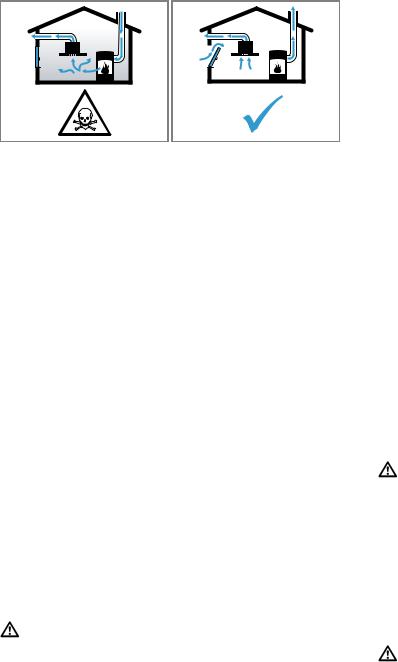
charge the exhaust gases into the open through an exhaust gas system (e.g. a chimney). With the extractor hood switched on, air is extracted from the kitchen and the adjacent rooms. Without an adequate supply of air, the air pressure falls below atmospheric pressure. Toxic gases from the flue or the extraction shaft are sucked back into the living space.
Always ensure adequate fresh air in the room if the appliance is being operated in exhaust air mode at the same time as a room-air-dependent heat-producing appliance is being operated.
It is only possible to safely operate the appliance if the pressure in the room in which the heating appliance is installed does not drop more than 4 Pa (0.04 mbar) below atmospheric pressure. This can be achieved whenever the air needed for combustion is able to enter through openings that cannot be sealed, for example in doors, windows, incoming/exhaust air wall boxes or by other technical means. An incoming/exhaust air wall box alone does not ensure compliance with the limit.
In any case, consult your responsible chimney sweep. They are able to assess the house's entire ventilation setup and will suggest the suitable ventilation measures to you.
Unrestricted operation is possible if the appliance is operated exclusively in circulat- ing-air mode.
WARNING ‒ Risk of fire!
Fatty deposits in the grease filters may catch fire.
Never operate the appliance without a grease filter.
Clean the grease filters roughly every 2 months.
Never work with naked flames close to the appliance (e.g. flambéing).
Safety en
Do not install the appliance near a solid fuel heating appliance (e.g. woodor coalburning) unless the heating appliance has a sealed, non-removable cover. There must be no flying sparks.
Hot oil or grease ignites very quickly.
Always supervise hot oil and fat.
Never extinguish burning oil or fat with water. Switch off the cooking zone. Extinguish flames carefully using a lid, fire blanket or something similar.
When gas burners are in operation without any cookware placed on them, they can build up a lot of heat. A ventilation appliance installed above the cooker may become damaged or catch fire.
Only operate the gas burners with cookware on them.
Operating multiple gas hobs at the same time generates a great deal of heat. A ventilation appliance installed above the cooker may become damaged or catch fire.
Only operate the gas hobs with cookware on them.
Select the highest fan setting.
Never operate two gas hobs simultaneously on the highest flame for longer than 15 minutes. Two gas hobs correspond to one large burner.
Never operate large burners of more than 5 kW with the highest flame for longer than 15 minutes, e.g. a wok.
WARNING ‒ Risk of burns!
The accessible parts of the appliance become hot during operation.
Never touch these hot parts.
Keep children at a safe distance.
The appliance will become hot during operation.
Allow the appliance to cool down before cleaning it.
WARNING ‒ Risk of injury!
Components inside the appliance may have sharp edges.
Carefully clean the appliance interior. Items placed on the appliance may fall off.
Do not place any objects on the appliance.
Changes to the electrical or mechanical assembly are dangerous and may lead to malfunctions.
3

en Avoiding material damage
Do not make any changes to the electrical or mechanical assembly.
The light emitted by LED lights is very dazzling, and can damage the eyes (risk group 1).
Do not look directly into the switched-on LED lights for longer than 100 seconds.
WARNING ‒ Risk of electric shock!
If the appliance or the power cord is damaged, this is dangerous.
Never operate a damaged appliance.
Never pull on the power cord to unplug the appliance. Always unplug the appliance at the mains.
If the appliance or the power cord is damaged, immediately unplug the power cord or switch off the fuse in the fuse box.
"Call Customer Service." → Page 9
Repairs to the appliance should only be carried out by trained specialist staff.
Incorrect repairs are dangerous.
Repairs to the appliance should only be carried out by trained specialist staff.
Only use genuine spare parts when repairing the appliance.
If the power cord of this appliance is damaged, it must be replaced by the manufacturer, the manufacturer's Customer Service or a similarly qualified person in order to prevent any risk.
An ingress of moisture can cause an electric shock.
Before cleaning, pull out the mains plug or switch off the fuse in the fuse box.
Do not use steamor high-pressure cleaners to clean the appliance.
WARNING ‒ Risk of explosion!
Highly caustic alkaline or highly acidic cleaning agents in conjunction with aluminium parts in the interior of the appliance may cause explosions.
Never use highly caustic alkaline or highly acidic cleaning agents. In particular, do not use commercial or industrial cleaning agents in conjunction with aluminium parts, e.g. grease filter on extractor hoods.
2 Avoiding material damage
Follow these instructions to prevent material damage to your appliance, accessories or other objects in your kitchen.
ATTENTION!
Condensate may cause corrosion damage.
To prevent condensation from building up, switch on the appliance during cooking.
If moisture gets into the controls, this may result in damage.
Never clean controls with a wet cloth. Incorrect cleaning damages the surfaces.
Follow the cleaning instructions.
Do not use harsh or abrasive detergents.
Clean stainless steel surfaces in the direction of the finish only.
Never clean controls with stainless steel cleaners.
Condensation that flows back in may damage the appliance.
The air extraction duct must be installed with a gradient of at least 1° from the appliance.
If you put incorrect stress on the design elements, they may break off.
Do not pull design elements.
Do not place objects on the design elements or hang objects from them.
There is a risk of surface damage if you do not peel off the protective film.
Remove the protective film from all parts of the appliance before using for the first time.
If one lamp is defective, this may overload the remaining lamps.
Replace any defective lamps.
3 Environmental protection and saving energy
Help protect the environment by using your appliance in a way that conserves resources and by disposing of reusable materials properly.
Information about current disposal methods are available from your specialist dealer or local authority.
3.1 Disposing of packaging
The packaging materials are environmentally compatible and can be recycled.
Sort the individual components by type and dispose of them separately.
4
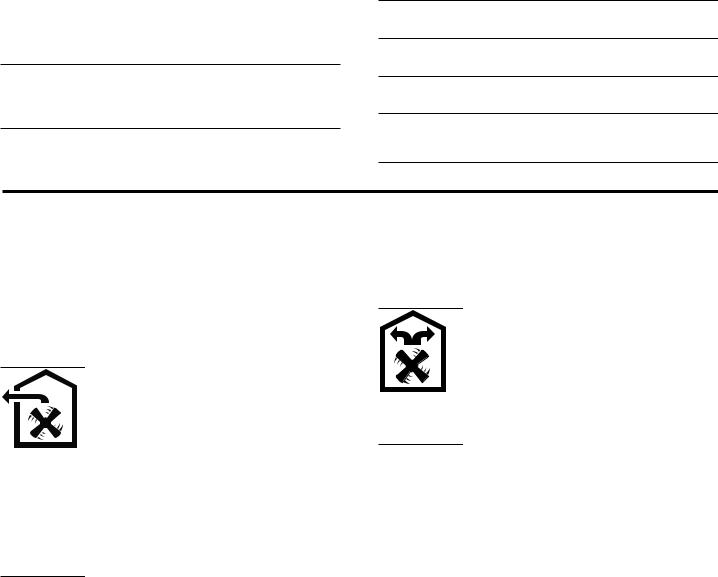
3.2 Saving energy
If you follow these instructions, your appliance will use less power.
Ensure that there is sufficient ventilation when cooking.
¡The appliance works more efficiently and with fewer operating noises.
Adjust the fan speed to the amount of steam produced during cooking.
¡The lower the fan speed, the less energy is consumed.
Operating modes en
If cooking produces large amounts of steam, select a higher fan speed in good time.
¡ The odours are distributed around the room less.
Switch the appliance off when you are not using it. ¡ The appliance does not consume any energy.
Switch off the lighting if you no longer require it. ¡ The lighting does not consume any energy.
Clean or replace the filters at regular intervals. ¡ The effectiveness of the filters is retained.
Put the cooking lid on.
¡The cooking vapours and condensation are reduced.
4 Operating modes
You can use your appliance in air extraction mode or circulating-air mode.
The saturation indicator must be adjusted to the selected operating mode and the filters used.
4.1 Air extraction mode
The air which is drawn in is cleaned by the grease filters and conveyed to the exterior by a pipe system.
The air must not be discharged into a flue that is used for exhausting fumes from appliances burning gas or other fuels (not applicable to appliances that only discharge the air back into the room).
¡If the exhaust air is to be conveyed into a non-functioning smoke or exhaust gas flue, you must obtain the consent of the heating engineer responsible.
¡If the exhaust air is conveyed through the external wall, a telescopic duct should be used.
4.2 Air recirculation mode
The air which is drawn in is cleaned by the grease filters and an odour filter, and conveyed back into the room.
To bind odours in circulating-air mode, you must install an odour filter. The different options for operating the appliance in circulating-air mode can be found in our catalogue. Alternatively, ask your dealer. The required accessories are available from specialist retailers, from customer service or from the Online Shop.
5
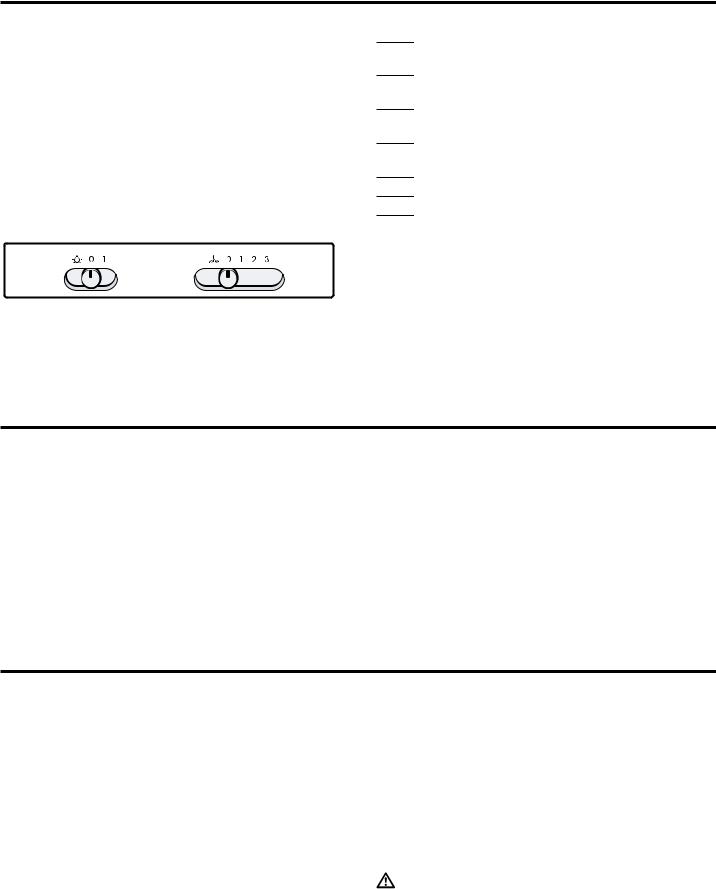
en Familiarising yourself with your appliance
5 Familiarising yourself with your appliance
Familiarise yourself with the parts of your appliance.
5.1 Controls
The controls are used to configure all functions of your appliance and to obtain information about the operating status.
 : Switches off the fan
: Switches off the fan
0
 : Switches on fan setting 1
: Switches on fan setting 1
1
 : Switches on fan setting 2
: Switches on fan setting 2
2
 : Switches on fan setting 3
: Switches on fan setting 3
3


 : 0 Switches off the lighting
: 0 Switches off the lighting


 : 1 Switches on the lighting
: 1 Switches on the lighting
6 Basic operation
You can find out everything you need to know about |
6.3 Switching off the appliance |
operating your appliance here. |
Set the slide control to position 0. |
|
6.1 Switching on the appliance
Set the slide control to position 1.
6.2 Setting a fan setting
Set the slide control to position 1, 2 or 3.
6.4 Switching on the lighting
The lighting can be switched on and off independently of the ventilation system.
Set the slide control to position 1.
6.5 Switching off the lighting
Set the slide control to position 0.
7 Cleaning and servicing
To keep your appliance working efficiently for a long time, it is important to clean and maintain it carefully.
7.1 Cleaning products
You can obtain suitable cleaning products from aftersales service or the online shop.
ATTENTION!
Unsuitable cleaning products may damage the surfaces of the appliance.
Do not use harsh or abrasive detergents.
Do not use cleaning products with a high alcohol content.
Do not use hard scouring pads or cleaning sponges.
Do not use any special cleaners for cleaning the appliance while it is hot.
Only use glass cleaners, glass scrapers or stainless steel care products if recommended in the cleaning instructions for the relevant part.
Wash sponge cloths thoroughly before use.
7.2 Cleaning the appliance
Clean the appliance as specified. This will ensure that the different parts and surfaces of the appliance are not damaged by incorrect cleaning or unsuitable cleaning products.
WARNING ‒ Risk of explosion!
Highly caustic alkaline or highly acidic cleaning agents in conjunction with aluminium parts in the interior of the appliance may cause explosions.
6

Never use highly caustic alkaline or highly acidic cleaning agents. In particular, do not use commercial or industrial cleaning agents in conjunction with aluminium parts, e.g. grease filter on extractor hoods.
WARNING ‒ Risk of electric shock!
An ingress of moisture can cause an electric shock.
Before cleaning, pull out the mains plug or switch off the fuse in the fuse box.
Do not use steamor high-pressure cleaners to clean the appliance.
WARNING ‒ Risk of burns!
The appliance will become hot during operation.
Allow the appliance to cool down before cleaning it.
WARNING ‒ Risk of injury!
Components inside the appliance may have sharp edges.
Carefully clean the appliance interior.
1.Observe the information regarding the cleaning agents.
2.Clean as follows, depending on the surface:
‒Clean stainless steel surfaces in the direction of the finish using a sponge cloth and hot soapy water.
‒Clean painted surfaces using a damp sponge cloth and hot soapy water.
‒Clean aluminium using a soft cloth and glass cleaner.
‒Clean plastic using a soft cloth and glass cleaner.
‒Clean glass using a soft cloth and glass cleaner.
3.Dry with a soft cloth.
4.Apply a thin layer of the stainless steel cleaning product to stainless steel surfaces using a soft cloth.
You can obtain stainless steel cleaning products from the after-sales service or the online shop.
7.3 Cleaning controls
WARNING ‒ Risk of electric shock!
Penetrating moisture may cause an electric shock.Do not use wet sponge cloths.
1.Observe the information regarding the cleaning agents.
2.Clean using a damp sponge cloth and hot soapy water.
3.Dry with a soft cloth.
Cleaning and servicing en
7.4 Removing the grease filter
1.ATTENTION!
Falling grease filters may damage the hob below.Grip below the grease filter with one hand. Open the locks on the grease filters.
2.Remove the grease filters from the holders.
To prevent grease from dripping, hold the grease filter horizontally.
7.5 Cleaning grease filters manually
The grease filters filter the grease from the cooking vapour. Regularly cleaned grease filters guarantee a high level of grease removal.
WARNING ‒ Risk of fire!
Fatty deposits in the grease filters may catch fire.
Clean the grease filters roughly every 2 months.
Requirement: The grease filters have been removed.
1.Observe the information regarding the cleaning agents.
2.Soak the grease filter in hot soapy water.
Use special grease solvent for stubborn dirt. You can obtain grease solvents from after-sales service or the online shop.
3.Use a brush to clean the grease filters.
4.Rinse the grease filters thoroughly.
5.Allow the grease filters to drain.
7.6 Cleaning grease filters in the dishwasher
The grease filters filter the grease from the cooking vapour. Regularly cleaned grease filters guarantee a high level of grease removal.
WARNING ‒ Risk of fire!
Fatty deposits in the grease filters may catch fire.
Clean the grease filters roughly every 2 months.
ATTENTION!
The grease filters may become damaged if they are squeezed.
Do not squeeze the grease filters.
Note: When cleaning the grease filter in the dishwasher, light discolouration may occur. This discolouration has no effect on the performance of the metal grease filters.
Requirement: The grease filters have been removed.
1.Observe the information regarding the cleaning agents.
7
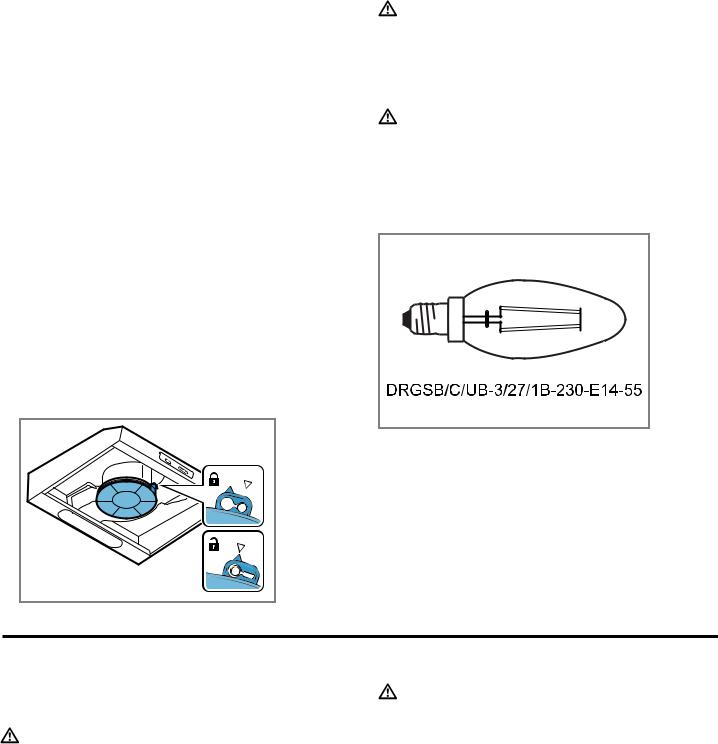
en Troubleshooting
2.Place the grease filters loosely into the dishwasher. Do not clean heavily soiled grease filters with utensils.
Use special grease solvent for stubborn dirt. You can obtain grease solvents from after-sales service or the online shop.
3.Start the dishwasher.
Select a temperature of no more than 70 °C.
4.Allow the grease filters to drain.
7.7 Fitting grease filters
ATTENTION!
Falling grease filters may damage the hob below.Grip below the grease filter with one hand.
1.Fit the grease filters.
2.Fold the grease filters upwards and engage the locks.
3.Make sure that the locks engage.
7.8 Odour filter for recirculating air mode
Odour filters bind odorous substances in air recirculation mode. Regularly replaced odour filters guarantee a high level of odour removal.
With normal use (approx. one hour a day), the odour filter must be replaced every 4 months. The odour filter cannot be cleaned or regenerated.
You can obtain odour filters from the after-sales service or the online shop. Only use original odour filters.
Replacing the odour filter
Requirement: The grease filters have been removed.
1.To open the locking mechanism on the odour filter, rotate the odour filter.
2.Remove the odour filter.
3.Insert the new odour filter.
4.To close the locking mechanism on the odour filter, rotate the odour filter.
7.9 Replacing the LED lights
WARNING ‒ Risk of electric shock!
When changing the bulb, the bulb socket contacts are live.
Before replacing the bulb, unplug the appliance from the mains or switch off the circuit breaker in the fuse box.
WARNING ‒ Risk of injury!
The light emitted by LED lights is very dazzling, and can damage the eyes (risk group 1).
Do not look directly into the switched-on LED lights for longer than 100 seconds.
Note:
Only use bulbs of the same type and wattage.
1.Disconnect the appliance from the power supply.
2.Remove the grease filters.
→ "Removing the grease filter", Page 7
3.Unscrew the bulb and replace it with a bulb of the same type.
4.Install the grease filters.
5.Insert the mains plug and switch on the fuse again.
8 Troubleshooting
You can rectify minor faults on your appliance yourself. Read the troubleshooting information before contacting after-sales service. This will avoid unnecessary costs.
WARNING ‒ Risk of injury!
Improper repairs are dangerous.
Repairs to the appliance should only be carried out by trained specialist staff.
If the appliance is defective, call Customer Service.
WARNING ‒ Risk of electric shock!
Incorrect repairs are dangerous.
Repairs to the appliance should only be carried out by trained specialist staff.
Only use genuine spare parts when repairing the appliance.
If the power cord of this appliance is damaged, it must be replaced by the manufacturer, the manufacturer's Customer Service or a similarly qualified person in order to prevent any risk.
8

Disposal en
8.1 Malfunctions |
|
|
|
Fault |
Cause & troubleshooting |
The appliance is not working. |
The mains plug of the power cord is not plugged in. |
|
Connect the appliance to the power supply. |
The circuit breaker is faulty.
Check the circuit breaker in the fuse box.
There has been a power cut.
Check whether the lighting in your kitchen or other appliances are working.
9 Disposal
Find out here how to dispose of old appliances correctly.
9.1 Disposing of old appliance
Valuable raw materials can be reused by recycling.
1.Unplug the appliance from the mains.
2.Cut through the power cord.
3.Dispose of the appliance in an environmentally friendly manner.
This appliance is labelled in accordance with European Directive 2012/19/EU concerning used electrical and electronic appliances (waste electrical and electronic equipment - WEEE).
The guideline determines the framework for the return and recycling of used appliances as applicable throughout the EU.
10 Customer Service
If you have any queries on use, are unable to rectify faults on the appliance yourself or if your appliance needs to be repaired, contact Customer Service.
You can solve many problems yourself by consulting the information on troubleshooting in these instructions or on our website. If this is not the case, contact our after-sales service.
We will always find an appropriate solution and try to avoid unnecessary visits being made by a Customer Service technician.
With any warranty claims, we will make sure that your appliance is repaired by trained after-sales technicians using genuine spare parts, including after the manufacturer's warranty has expired.
Detailed information on the warranty period and terms of warranty in your country is available from our aftersales service, your retailer or on our website.
If you contact Customer Service, you will require the product number (E-Nr.) and the production number (FD) of your appliance.
The contact details for Customer Service can be found in the enclosed Customer Service directory or on our website.
10.1 Product number (E-Nr.) and production number (FD)
You can find the product number (E-Nr.) and the production number (FD) on the appliance's rating plate. Depending on the model, the rating plate can be found:
¡Inside the appliance (remove grease filters for access).
¡On top of the appliance.
Make a note of your appliance's details and the Customer Service telephone number to find them again quickly.
11 Installation instructions
Observe this information when installing the appliance.
9
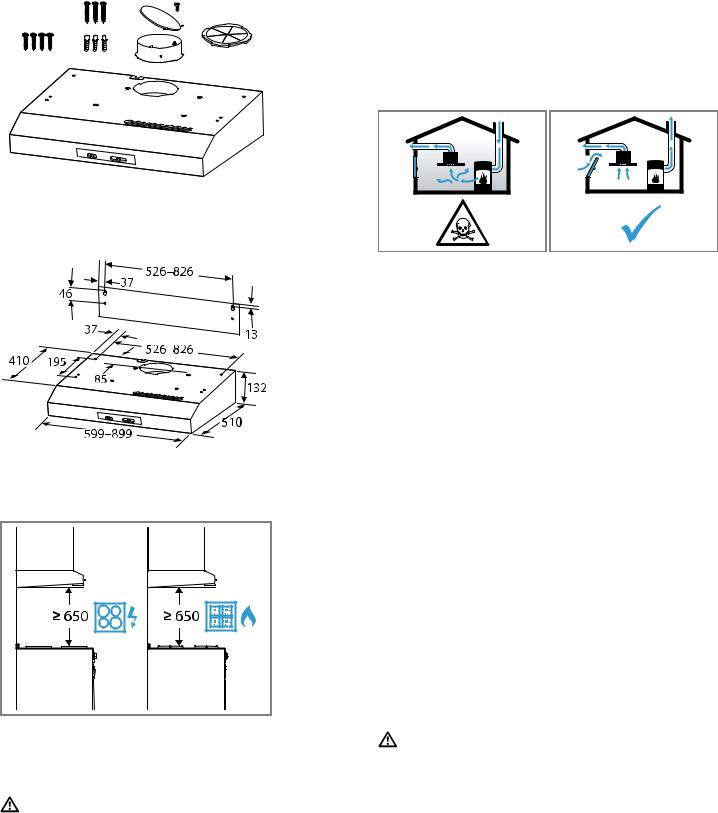
en Installation instructions
11.1 Scope of delivery
After unpacking all parts, check for any damage in transit and completeness of the delivery.
11.2 Appliance dimensions
You will find the dimensions of the appliance here
11.3 Safety clearances
Comply with the safety clearances for the appliance.

 11.4 Secure installation
11.4 Secure installation
Follow these safety instructions when installing the appliance.
WARNING ‒ Risk of poisoning!
Risk of poisoning from flue gases being drawn back in. Room-air-dependent heat-pro- ducing appliances (e.g. gas, oil, wood or coaloperated heaters, continuous flow heaters or
water heaters) obtain combustion air from the room in which they are installed and discharge the exhaust gases into the open through an exhaust gas system (e.g. a chimney). With the extractor hood switched on, air is extracted from the kitchen and the adjacent rooms. Without an adequate supply of air, the air pressure falls below atmospheric pressure. Toxic gases from the flue or the extraction shaft are sucked back into the living space.
Always ensure adequate fresh air in the room if the appliance is being operated in exhaust air mode at the same time as a room-air-dependent heat-producing appliance is being operated.
It is only possible to safely operate the appliance if the pressure in the room in which the heating appliance is installed does not drop more than 4 Pa (0.04 mbar) below atmospheric pressure. This can be achieved whenever the air needed for combustion is able to enter through openings that cannot be sealed, for example in doors, windows, incoming/exhaust air wall boxes or by other technical means. An incoming/exhaust air wall box alone does not ensure compliance with the limit.
In any case, consult your responsible chimney sweep. They are able to assess the house's entire ventilation setup and will suggest the suitable ventilation measures to you.
Unrestricted operation is possible if the appliance is operated exclusively in circulat- ing-air mode.
WARNING ‒ Risk of suffocation!
Children may put packaging material over their heads or wrap themselves up in it and suffocate.
Keep packaging material away from children.
Do not let children play with packaging material.
10
